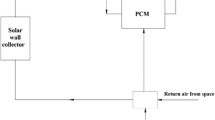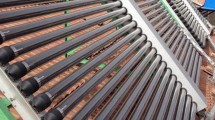Abstract
A dual-channel solar thermal storage wall system with eutectic phase change material is studied. The full-day cooling load in summer and heating load in winter can be both decreased by this novel system. To investigate the airflow in the dual channel, mixed area assumptions based on the experimental results are summarized. Dynamic mathematical models of the system under four work modes are established and verified by the experimental results. The average RMSD (root mean square deviation) value is 0.35% in summer and 0.95% in winter. By analyzing the heat flux, the combination of dual channel and PCM is proven to decrease and delay cooling load both in the daytime and nighttime of summer. In winter’s daytime, the thermal efficiency is promoted by the dual channel. And in winter’s nighttime, the system is able to heat the room constantly by the PCM boards. Based on parameter researches, the optimum phase change temperature range and the optimum thickness of the PCM are 26–30 °C, 1.5 cm in summer and 16–22 °C, 0.6 cm in winter respectively. To reach the optimum annual thermal performance, the coverage area is 2 m2 for this system.
Similar content being viewed by others
Abbreviations
- A :
-
area (m2)
- C :
-
loss coefficient
- c :
-
thermal capacity (J/(kg·K))
- D :
-
duct hydraulic diameter (m)
- d :
-
thickness (m)
- f :
-
view factor
- Gr :
-
Grashof number
- h :
-
convection coefficient (W/(m2·K))
- h rad :
-
radiation coefficient (W/(m2·K))
- I :
-
solar radiation (W/m2)
- k :
-
conduction coefficient (W/(m·K))
- L :
-
length (m)
- m :
-
mass (kg)
- Nu :
-
Nusselt number
- T :
-
temperature (°C)
- V :
-
speed (m/s)
- α :
-
absorption rate
- ν :
-
aerodynamic viscosity (m2/s)
- ε :
-
emissivity factor
- β :
-
factor of expansion (K−1)
- σ :
-
Boltzmann constant
- ρ :
-
density (kg/m3)
- amb:
-
ambient
- board:
-
absorber plate
- channel:
-
air channel
- g:
-
glass
- i, j, k :
-
surface
- PCM:
-
PCM plate
- rad:
-
radiation
- sw:
-
south wall
- v:
-
vent
References
Abo-Elfadl S, Hassan H, El-Dosoky MF (2020). Study of the performance of double pass solar air heater of a new designed absorber: An experimental work. Solar Energy, 198: 479–489.
Akhbari M, Rahimi A, Hatamipour MS (2020). Modeling and experimental study of a triangular channel solar air heater. Applied Thermal Engineering, 170: 114902.
Berthou Y, Biwole PH, Achard P, et al. (2015). Full scale experimentation on a new translucent passive solar wall combining silica aerogels and phase change materials. Solar Energy, 115: 733–742.
Clarke JA (2001). Energy Simulation in Building Design, 2nd edn. Oxford, UK: Butterworth-Heinemann.
De Gracia A, Navarro L, Castell A, et al. (2013). Experimental study of a ventilated facade with PCM during winter period. Energy and Buildings, 58: 324–332.
Duan S, Wang L, Zhao Z, et al. (2021). Experimental study on thermal performance of an integrated PCM Trombe wall. Renewable Energy, 163: 1932–1941.
Elghamry R, Hassan H (2020). Experimental investigation of building heating and ventilation by using Trombe wall coupled with renewable energy system under semi-arid climate conditions. Solar Energy, 201: 63–74.
Gan G (1998). A parametric study of Trombe walls for passive cooling of buildings. Energy and Buildings, 27: 37–43.
Ibn-Mohammed T, Greenough R, Taylor S, et al. (2013). Operational vs. embodied emissions in buildings—A review of current trends. Energy and Buildings, 66: 232–245.
Jaber S, Ajib S (2011). Optimum design of Trombe wall system in Mediterranean region. Solar Energy, 85: 1891–1898.
Ji J, Yi H, He W, et al. (2007). Modeling of a novel Trombe wall with PV cells. Building and Environment, 42: 1544–1552.
Ji J, Luo C, Chow TT, Sun W, He W (2011). Thermal characteristics of a building-integrated dual-function solar collector in water heating mode with natural circulation. Energy, 36: 566–574.
Khalifa AJN, Marshall RH (1990). Validation of heat transfer coefficients on interior building surfaces using a real-sized indoor test cell. International Journal of Heat and Mass Transfer, 33: 2219–2236.
Kumar R, Rosen MA (2011). Performance evaluation of a double pass PV/T solar air heater with and without fins. Applied Thermal Engineering, 31: 1402–1410.
Li T, Liu Y, Chen Y, et al. (2018). Experimental study of the thermal performance of combined floor and Kang heating terminal based on differentiated thermal demands. Energy and Buildings, 171: 196–208.
Liu Y, Hou L, Yang Y, et al. (2020). Effects of external insulation component on thermal performance of a Trombe wall with phase change materials. Solar Energy, 204: 115–133.
Luo C, Xu L, Ji J, et al. (2017). Experimental study of a modified solar phase change material storage wall system. Energy, 128: 224–231.
Luo C, Xu L, Ji J, et al. (2018). Thermal feature of a modified solar phase change material storage wall system. International Journal of Photoenergy, 2018: 6071589.
McAdams WH (1954). Heat Transmission, 3rd edn. New York: McGraw-Hill.
Moreno S, Hinojosa JF, Hernández-López I, et al. (2020). Numerical and experimental study of heat transfer in a cubic cavity with a PCM in a vertical heated wall. Applied Thermal Engineering, 178: 115647.
Murali G, Nandan BS, Reddy NSK, et al. (2020). Experimental study on double pass solar air heater with fins at lower and upper channel. Materials Today: Proceedings, 21: 578–583.
Nejat P, Jomehzadeh F, Taheri MM, et al. (2015). A global review of energy consumption, CO2 emissions and policy in the residential sector (with an overview of the top ten CO2 emitting countries). Renewable and Sustainable Energy Reviews, 43: 843–862.
Oluah C, Akinlabi ET, Njoku HO (2020). Selection of phase change material for improved performance of Trombe wall systems using the entropy weight and TOPSIS methodology. Energy and Buildings, 217: 109967.
Salih MMM, Alomar OR, Ali FA, et al. (2019a). An experimental investigation of a double pass solar air heater performance: a comparison between natural and forced air circulation processes. Solar Energy, 193: 184–194.
Salih SM, Jalil JM, Najim SE (2019b). Experimental and numerical analysis of double-pass solar air heater utilizing multiple capsules PCM. Renewable Energy, 143: 1053–1066.
Sergei K, Shen C, Jiang Y (2020). A review of the current work potential of a Trombe wall. Renewable and Sustainable Energy Reviews, 130: 109947.
Stazi F, Mastrucci A, di Perna C (2012). The behaviour of solar walls in residential buildings with different insulation levels: an experimental and numerical study. Energy and Buildings, 47: 217–229.
Su D, Jia Y, Huang X, et al. (2016). Dynamic performance analysis of photovoltaic-thermal solar collector with dual channels for different fluids. Energy Conversion and Management, 120: 13–24.
Sun W, Ji J, Luo C, He W (2011). Performance of PV-Trombe wall in winter correlated with south façade design. Applied Energy, 88: 224–231.
Tchinda R (2009). A review of the mathematical models for predicting solar air heaters systems. Renewable and Sustainable Energy Reviews, 13: 1734–1759.
Tuncer AD, Khanlari A, Sözen A, et al. (2020). Energy-exergy and enviro-economic survey of solar air heaters with various air channel modifications. Renewable Energy, 160: 67–85.
Wahid MA, Hosseini SE, Hussen HM, et al. (2017). An overview of phase change materials for construction architecture thermal management in hot and dry climate region. Applied Thermal Engineering, 112: 1240–1259.
Wang D, Hu L, Du H, et al. (2020). Classification, experimental assessment, modeling methods and evaluation metrics of Trombe walls. Renewable and Sustainable Energy Reviews, 124: 109772.
Xing Y, Hewitt N, Griffiths P (2011). Zero carbon buildings refurbishment—A Hierarchical pathway. Renewable and Sustainable Energy Reviews, 15: 3229–3236.
Xiong Y, Liu J, Kim J (2019). understanding differences in thermal comfort between urban and rural residents in hot summer and cold winter climate. Building and Environment, 165: 106393.
Xu L, Ji J, Luo C, et al. (2017). Comparative research on solar phase change material storage wall systems under different summer working conditions. Energies, 10: 1878.
Xu L, Ji J, Luo K, et al. (2020). Annual analysis of a multi-functional BIPV/T solar wall system in typical cities of China. Energy, 197: 117098.
Yu B, Li N, Ji J (2019). Performance analysis of a purified Trombe wall with ventilation blinds based on photo-thermal driven purification. Applied Energy, 255: 113846.
Zalewski L, Joulin A, Lassue S, et al. (2012). Experimental study of small-scale solar wall integrating phase change material. Solar Energy, 86: 208–219.
Zhou G, Pang M (2015a). Experimental investigations on thermal performance of phase change material—Trombe wall system enhanced by delta winglet vortex generators. Energy, 93: 758–769.
Zhou G, Pang M (2015b). Experimental investigations on the performance of a collector-storage wall system using phase change materials. Energy Conversion and Management, 105: 178–188
Acknowledgements
This research is supported by the National Natural Science Foundation of China (No. 51878636, No.51908527); the Jiangxi Provincial Key Technology R&D Program, China (No. 20202BBEL53033); the Key Research and Development Project of Anhui Province, China (201904a07020014); Young and Middle-aged Teacher Education Research Project 2020 (Science and Technology); the Education Department of Fujian Province (No. JAT200284); Research Start-Up Fund of Jimei University (ZQ2020016).
Author information
Authors and Affiliations
Corresponding author
Rights and permissions
About this article
Cite this article
Xu, L., Luo, C., Cai, J. et al. Modeling and analysis of a dual-channel solar thermal storage wall system with phase change material in hot summer and cold winter area. Build. Simul. 15, 179–196 (2022). https://doi.org/10.1007/s12273-021-0805-8
Received:
Revised:
Accepted:
Published:
Issue Date:
DOI: https://doi.org/10.1007/s12273-021-0805-8




